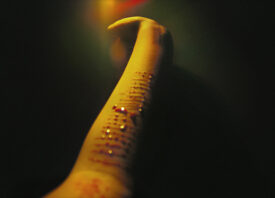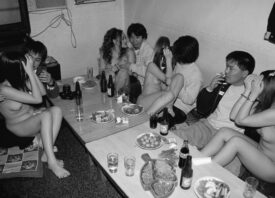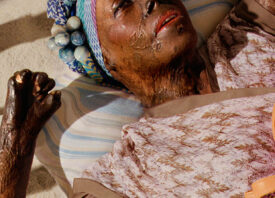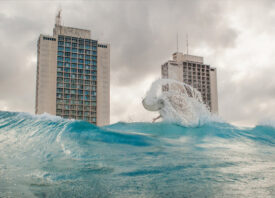Search this site
A Survivor Navigates Childhood Trauma Through Photography


“As I made these images, I was becoming aware that my body was remembering what it had gone through and was going through,” the photographer Veronica Cruz tells me. “But I was also learning that it was okay to let it out and feel all of this without shame and without feeling like I had to hide it.” In Little Earthquakes, the artist navigates childhood trauma through photography.
Cruz was raped as a child; she does not know when it started, but it continued until she was eight. At the age of twelve, she had emergency brain surgery and was hospitalized due to an AVM, an abnormal connection between the arteries and veins in her brain. “There was one moment when I went from having fun being a kid to having an hour left to live,” the artist says. She remembers that particular moment vividly, in slow motion. Other moments she can’t remember at all.
Little Earthquakes is a work-in-progress, following the artist as she revisits the past and copes with the ongoing tremors reverberating in the aftermath of trauma. Early in the process, she was encouraged by a conversation with a friend, who is also a survivor. “It was the first time I didn’t feel alone,” she remembers now.
With the support of friends and family—her mother and grandmother—she continued making photographs and writing about her experiences. “The friend I shared my story with would remind me that none of it was my fault,” Cruz says. “I was so used to the traditional ways of thinking: ‘what happened in the past stays in the past, now just move on.’ But I understood that’s just not how it works, especially with such trauma.”
For one of the photographs, Cruz returned to the house where she was raped. Some were made in the hospital. Most of the photographs were created in and around the artist’s home, with the light itself becoming a recurring figure. While navigating PTSD, the artist had flashbacks and intrusive memories involving light.
“One of the things I kept seeing was the light from his window onto the bed,” she explains. “Other times, it almost seemed like I could feel the light on my face. Any time I saw a certain light, usually in the morning—for the times I woke up in his bed or the light when the sun was setting, for the times I try not to remember—I started photographing.”
While the rays of light carry the weight of the past, I can’t help but think that perhaps they also contain another layer of meaning, calling to mind the idea of bringing the truth “out of the shadows” and “into the light.” In that way, the shafts of sunlight that appear throughout Little Earthquakes become like a refrain—a recurring reminder these things happened and cannot be relegated to darkness.
Cruz remembers the harsh hospital lighting too. After immediate surgery at the age of twelve, she was hospitalized for two weeks. For four months after that, she was an inpatient at a rehabilitation program. “I couldn’t eat/drink, talk, or breathe on my own for some time and had to relearn it all,” she explains.
“I was scared all the time. I live with the haunting memories of what I’ve seen at rehab—one being another kid, burned head to toe. Another where my friend was dying. Another where my friend who had an AVM did die even after things were going so well.”
She grappled with anger and confusion over the fact that she hadn’t died herself—and the unbearable fear that she would. She wanted to live. At fourteen, she had her first seizure. More seizures, tests, and procedures followed. She remembers crying in the CAT scan machine, thinking they’d find something fatal: “I really thought I’d end up dying.”
“It will have been eleven years on March 30th,” the artist reflects. “I am still navigating a world that isn’t as disability friendly, and I still am, and possibly will forever have to deal with a mostly paralyzed arm (left) and a weaker leg (left).”
Cruz grew up Catholic, so religious iconography naturally and organically made its way into the work, bringing with it a sense of ambivalence. On one hand, there’s anger and uncertainty—sparked by the question that if God exists, how was this allowed to happen? Why wasn’t she protected? At the same time, though, these religious motifs speak to a sense of hope and faith in the face of unbearable pain.
Cruz knows that other survivors will see her work. “I want them to know that it is not easy, but that they can do it,” she tells me. “They can push through and move forward. What has happened or is happening doesn’t define them. This is where you grow and become stronger because we are the ones who understand life better than most. It will be a rollercoaster, but know that you are not alone. It truly is one step at a time, one day at a time. To survivors of assault, it was never your fault.”
In some ways, the photographs represent an acknowledgment of the artist’s younger self—seen literally in an old family picture, where she’s bundled in a pink coat, and figuratively in an empty swing, swaying gently on a snowy evening. The past and present collide and overlap. Each time the artist herself appears throughout Little Earthquakes, whether she’s gazing directly at the camera or cradling her body, she reinforces the simple fact of her survival: she’s still here.
In the early stages of making this work, Cruz experienced a pervasive sense of numbness, accompanied by loneliness. Revisiting trauma through photography was not immediately cathartic, and in the beginning, it did not feel healing. It just felt terrifying and exhausting, causing her to dissociate. But with the support of friends, family, and professors, she slowly started to feel less alone. The numbness dissipated. Right now, she sees the work continuing indefinitely and possibly forever.
“I think the only time this project could end is when I feel like I no longer have to protect and heal the inner child inside of me,” the artist says. “While making this work, I was starting to learn more about myself, and I became less ashamed to say that I wasn’t doing okay or admit I was scared. The moment it became cathartic was during certain times when creating. I found myself crying during the process or after. I was becoming aware there was the eight-year-old girl and twelve-year-old in me, finally starting to release what I never felt I could.”










All images © Veronica Cruz
- Read this next: we recently interviewed Izabela Jurcewicz, a rare tumor survivor navigating trauma through photography.



